| Ambystoma opacum | |||||||||
| Marbled Salamander | |||||||||
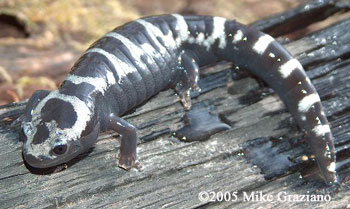
|
|
Description
Marbled salamanders (Ambystoma opacum, Urodela: Family Ambystomatidae) are a medium-sized chunky salamander reaching up to 4.25 inches in length (10.8 cm). As adults they have a variable number of white bars on the body. Like other ambystomatids, these salamanders spend most of their time underground in burrows and are infrequently seen outside of the breeding season. The amount of time that ambystomids spend underground, in their own or other animals' burrows, has caused them to be called "mole salamanders".
Natural Range and Habitat
Marbled salamanders are found from southern New England, west to parts of Texas, Illinois, Oklahoma, and south to northern Florida. Marbled salamanders are found in a variety of habitats, ranging from moist sandy/gravelly areas to dry hillsides and areas bordering ponds and slow moving streams.
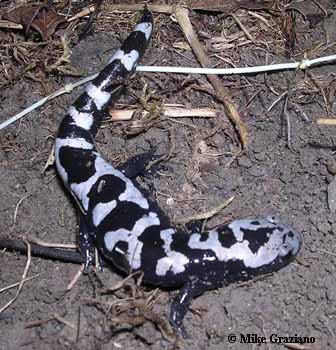 |
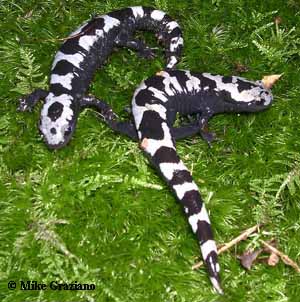 |
Housing
Marbled salamanders should be kept in a cool area such as a temperature-controlled room. The salamander should not be exposed to temperatures over 30°C (86°F) for extended periods of time as death may result. A temperature regimen between 18°C (65°F) and 24 C (75°F) seems to work very well for rearing larvae and maintaining adults (personal observations).
Adult marbled salamanders may be maintained either singly or in small groups. Metamorphosed ambystomid salamanders do seem to be territorial with regards to conspecifics (Stebbins, Cohen, 1995). The adults, particularly the males, will bite each other on the snout and actively try to avoid each other if possible. If they have enough space available to avoid each other, then aggression may be reduced, but there will be an increase in stress, possibly resulting in lack of appetite, risk of infections, and lack of interest in courtship and breeding. There is some evidence that ambystomid salamanders may be aggressive toward plethodontid salamanders (Ducey, et. al., 1994). Size should always be considered before placing salamanders together, as larger conspecifics may devour smaller ones. For one or two adult marbled salamanders, a plastic shoebox with some ventilation holes drilled into the top of the corners is appropriate. Up to four or five adult marbled salamanders may be housed in a plastic sweater box. In housing any salamander, tight fitting lids are a necessity to prevent escape.
Moistened unbleached paper towels may be used as a substrate. The paper towels may be changed once to twice a week depending on the feeding regimen. The enclosure should be cleaned the day after feeding to remove uneaten or dead food items. This will prevent fouling of the enclosure by uneaten food items. Crumpling up the unbleached paper towels will allow the salamanders to shelter in the resulting crevices. The towels should be moistened with dechlorinated water.
If kept with dirt or other loose substrate, marbled salamanders will burrow in an enclosure if the substrate is of a sufficient depth. This will prevent easy viewing of the salamanders. A shallow substrate with several slanted shelters of rocks or bark will allow the salamanders to have shelter and still be readily viewed. Deep pools or dishes of water are to be avoided in housing marbled salamanders, as they are poor swimmers.
Larvae are reared in typical aquatic conditions. Water quality should be tested at least twice a week if all of the parameters have been acceptable. The pH of the enclosures should not be below 6.5, as growth inhibition may occur (Ireland, 1991). If the water tests are showing levels of ammonia or nitrite, then water changes with dechlorinated water and daily testing may be necessary until the problem is resolved. Water changes should be made at a minimum of once a week. The water changes should consist of at least 10-20% of the total volume of the enclosure. Alternatively, small daily water changes can be conducted by using a length of airline tubing to remove any waste products or uneaten food. By using the airline tubing to siphon water, the accidental siphoning of larval salamanders can be avoided. All siphoned water should be replaced with an equal volume of dechlorinated tap water. If any of the enclosures require sterilization, then a solution of bleach and water can be used (Wright, 1993, Wright, 1994, Rossi and Rossi, 1994). No iodine-based cleaners should be used on an amphibian enclosure as iodine leaching may result in amphibian deaths (Wright, 1993). Larval Ambystoma salamanders should not be exposed to ultraviolet light or temperatures approaching the upper limit as developmental abnormalities may result (Worthington, 1974).
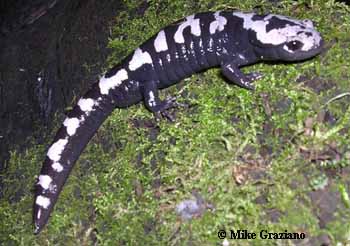 |
Marbled salamander larvae that are close to metamorphosis should be maintained in a shoebox or a small aquarium. The enclosure should be tilted until a gentle slope is attained. Dechlorinated water is added to create a shallow reservoir at one end. Some flat pieces of stone or cork bark should be placed on the slope to allow for traction for the juveniles to climb out of the water. Some crumpled unbleached paper towels may be moistened and placed on the top of the slope to provide shelter. Some small stones or plants may be placed in the reservoir end to allow for visual barriers. There is some discussion as to aggression in larval ambystomid salamanders (Walls and Semlitsch, 1991). Marbled salamander larvae, until close to the age of metamorphosis, may be maintained in a small aquarium with a sponge filter. The sponge filter should be rinsed out weekly. Marbled salamanders should not be maintained in crowded conditions, as decreased growth and a smaller size at metamorphosis may result (Stenhouse, et al., 1983; Brodman, 1996). The signs that metamorphosis is imminent are the reduction and absorption of the gills, and thickening of the tail. Once a marbled salamander has fully metamorphosed, it should be removed from the shoebox containing water and set up as an adult as soon as possible, as the salamander may drown. Depending on the locality of origin, sexual maturity can take from one to two years. The more northern the locality of origin, the longer the time period to sexual maturity. Marbled salamanders, unlike other ambystomid salamanders, will readily drown if they are prevented from climbing out of the water (Noble and Brady, 1996). Any metamorphosed marbled salamanders kept in an aquatic situation will show signs of distress by attempting to escape the water. If the marbled salamander is not removed, the salamander will drown.
Marbled salamanders should be treated for parasitic helminthes on acclimation and again at 14-21 days. Seven to 10 days after the second treatment, fecal samples should be submitted to a veterinarian for examination. Rubber gloves should be worn when handling or restraining all amphibians to prevent transmission of parasites or diseases to subsequent animals or cages.
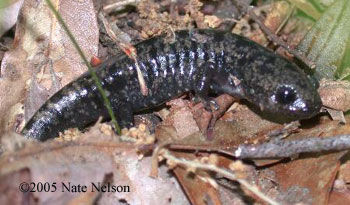
A. opacum color variant. |
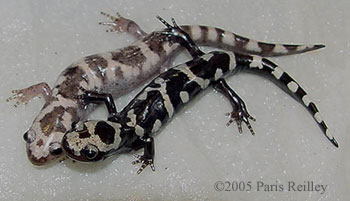
A. opacum color variant. |
Feeding
Adult marbled salamanders may be maintained on a diet of two week old crickets (Acheta domestica) and wax worms (Galleria mellonella). The amount and frequency of the feeding of marbled salamanders should be based on temperature. The lower the temperature, the less frequently feeding is required. At 15°C (59°F), a diet of four crickets a week assures growth and sufficient nutrition for oogenesis (Scott and Fore, 1995). At an average temperature of 18°C (65°F), adult marbled salamanders will do well on a diet of four to six two-week-old crickets twice a week per salamander (personal observation). At higher temperatures, a greater frequency of feeding is required to ensure adequate nutrition. Waxworms are high in fat and should be used primarily as an occasional food item, or to put weight on thin or stressed animals. Waxworms also have the drawback of having an indigestible skin (Vosjoli, 1994, Staniszewski, 1995). If the skin is pricked or broken prior to feeding, the digestibility of the waxworms can be improved. Due to their low metabolic requirements, the majority of adult marbled salamanders that I have observed in captivity have been very obese.
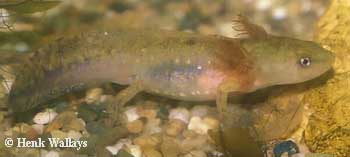
Larval marbled salamanders should be fed ad libitum by maintaining a small supply of live food in with the larvae. Keeping the larvae well fed will reduce incidences of cannibalism. Suitable food choices depend on the size of the larvae. Newly hatched larvae should be fed small food items like newly hatched brine shrimp naupli (Artemia salina), chopped white worms (Enchytraeus sp.), chopped tubifex worms (Tubifex sp.), daphnia (Daphnia sp.) and cyclops (Cyclops sp.). Be careful when feeding cyclops to very small larvae, as cyclops are known to prey on larval fish. Larval salamanders more than one to two weeks old should be offered larger prey items like adult brine shrimp, daphnia, bloodworms (Chironomus sp.), glassworms (Cothra sp. or Chaoborus sp.), whole tubifex worms, black worms (Lumbriculus variegatus) and chopped red worms (Lumbriculus sp.). All aquatic live foods for larval salamanders should be closely scrutinized before feeding for possible predators such as Hydra (Hydra sp.), water tigers (Dytiscus marginalis), dragonfly larvae (Odonata sp.), water boatmen (Notonecta sp.), and water scorpions (Nepa cinera). Tubifex worms and bloodworms may have some drawbacks as food sources. Tubifex worms are collected from drainage ditches and sewage outflows and may contain pathogenic bacteria. Bloodworms may come from waters that are contaminated with heavy metals. Newly transformed salamanders should be offered flightless fruit flies (Drosophilia melanogaster and Drosophilia hydei sturtevant), and pinhead to 10-day-old crickets (Acheta domestica). Newly transformed salamanders should be fed every day to every other day. All food items for terrestrial salamanders should be dusted with an appropriate vitamin supplement. When the marbled salamanders are about six months old, the salamanders can be moved to an adult feeding regimen.
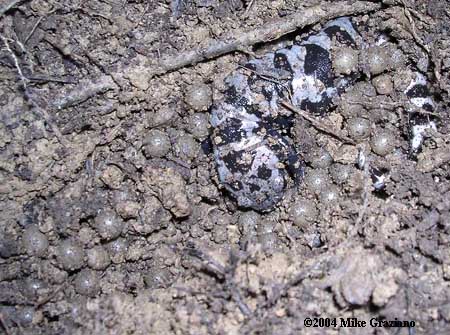
Female A. opacum with eggs.
Breeding
Marbled salamanders have some differences in their life history compared to other members of the family ambystomatidae. Marbled salamanders are autumnal breeders. They lay their eggs in the flood zone of temporary ponds, swamps, and slow streams that lack predatory fish populations. Marbled salamanders practice terrestrial courtship and egg deposition on the land, unlike most of the other ambystomid salamanders (Noble and Brady, 1933). Many female salamanders have already bred prior to arriving at the nesting site (Noble and Brady, 1933; Krenz and Scott, 1994). This terrestrial courtship may cause difficulties with captive breeding due to the Coolidge effect (Donovan and Verrell, 1991). The Coolidge effect occurs when there is either a cessation of courtship and subsequent breeding or reduction in breeding due to familiarity of the pair of animals. To stimulate more successful courtships, the males and the females should be housed separately until breeding time. A male that is ready for breeding will have a swollen cloaca, while the females will increase in girth as the eggs ripen. During the breeding season, the males will also exhibit whiter stripes along the back while females will have a duller or grayer color (Noble and Brady, 1933; personal observation). One male at a time should be introduced to a female in a plastic shoebox with a moistened unbleached paper towel as the substrate. More than two males may have a negative effect on breeding success due to interference and competition for the female (Verrell, 1989).
The paper towel provides a proper deposition surface for the spermatophore, and detection of successful deposition and retrieval of the spermatophore. Successful spermatophore pickup can be determined by whether the cap is still in place on the spermatophore. The spermatophore will look like a clear jelly cone 4-4.5 mm wide at the top to 6 mm wide at the base (Noble and Brady, 1933). An unretrieved spermatophore will have a small white cap attached to the top. Courtship in the wild has occurred at temperatures up to 23.3 to 26.5°C (74-79.7°F). Breeding and oviposition seems to be triggered primarily by humidity. Unlike most other ambystomid salamanders, oviposition occurs before the rains and subsequent flooding, so a rain chamber probably is not advantageous for stimulating breeding. In a related species, the spotted salamander (Ambystoma maculatum), ovulation is independent of the factors causing migration and courtship (Shoop, 1967). Females may lay up to 200 eggs.
Unlike other ambystomid salamanders, marbled salamanders incubate their eggs. The female will stay with the eggs until several weeks have passed, or until the clutch is inundated by rising water, or until the clutch is disturbed. Because marbled salamanders return to their natal site for reproduction, hormonal stimulation may be necessary to prevent egg retention. An alternate plan would be to collect eggs or larvae and rear them in captivity. This will cause the salamander to imprint on the captive conditions and enhance the chances of reproduction.
A breeding setup should have a gentle slope down into a shallow reservoir that is not more than one to two inches deep. The slope should contain multiple sites for the salamanders to hide or deposit the eggs. Appropriate sites can consist of an object overlaying the substrate. Appropriate nesting site covers can be made from cork bark or a layer of moistened sphagnum moss. If using sphagnum moss, the moss should not be allowed to remain soaked as humidity plays an important role in selection of a nesting site (Noble and Brady, 1933). The substrate underneath of the cover should be soft enough for the female to be able to excavate the nest. After egg deposition, the egg mass can be removed and placed into the rearing enclosure to incubate and hatch. The egg mass should be submerged in a small aquarium containing dechlorinated tap water and an airstone or a sponge filter. The eggs will not develop properly unless submerged (Noble and Brady, 1933). The eggs will hatch over a period of days after immersion in the water. This will mean that the larvae will need to be removed as they hatch to prevent different sized larvae from preying upon each other. Any eggs that develop fungus should be manually removed to prevent the fungus from spreading.
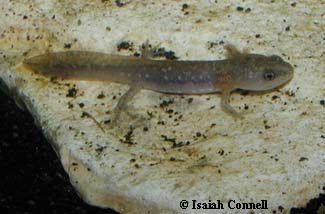 A. opacum larva. |
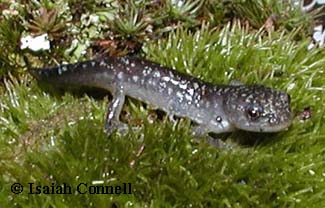 A. opacum juvenile. The characteristic banded pattern develops gradually during the first months after metamorphosis. |
References
Behler, John L., King, F. Wayne, 1979, The Audubon Society Field Guide to North American Reptiles and Amphibians, Alfred A. Knopf, Inc., New York.
Bishop, Sherman C., 1943, Handbook of Salamanders, Comstock Publishing Associates, Ithaca.
Breen, John F., 1974, Encyclopedia of Reptiles and Amphibians, T.F.H. Publications, Inc., Neptune.
Brodman, Robert, 1996, Effects of intraguild interactions on fitness and microhabitat use of larval Ambystoma salamanders. Copeia 2:372-378.
Conant, Roger, Collins, Joseph T., 1991, A Field Guide to Reptiles and Amphibians of Eastern and Central North America, Houghton Mifflin Company, Boston.
Doody, J. Sean, 1996, Larval growth rate of known age Ambystoma opacum in Louisiana under natural conditions. Journal of Herpetology 30(2): 297-300.
Donovan, Adriana, Verrell, Paul A., 1991, The effects of partner familiarity on courtship success in the salamander Desmognathus ochrophaeus. Journal of Herpetology 25(1): 93-95.
Ducey, Peter K., Schramm, Krista, Cambry, Nathalie, 1994, Interspecific aggression between the sympatric salamanders, Ambystoma maculatum and Plethodon cinereus. The American Midland Naturalist 131(2): 320-329.
Gatz Jr., A. John, 1971, Critical thermal maxima of Ambystoma maculatum (Shaw) and Ambystoma jeffersonianum (Green) in relation to time of breeding. Herpetologica 27:157-160.
Ireland, Patrick H., 1991, Separate effects of acid-derived anions and cations on the growth of larval salamanders of Ambystoma maculatum. Copeia 1: 132-137.
Keen, W. Hubert, 1975, Breeding and larval development of three species of Ambystoma in central Kentucky(Amphibia: Urodela) Herpetologica 31(1): 18-21.
Krenz, John D., Scott, David E., 1994, Terrestrial courtship affects mating locations in Ambystoma opacum. Herpetologica 50 (1): 46-50.
Kuzmin, Sergius L., 1995, The problem of food competition in amphibians. Herpetological Journal 5(3): 252-256.
Lane-Petter, W., 1963, Animals for Research, Principles of Breeding and Management, Academic Press, New York.
Mattison, Chris, 1982, The Care of Reptiles and Amphibians in Captivity, Blanford Press, New York.
Mattison, Chris, 1993, Keeping and Breeding Amphibians, Blanford Press, New York.
McInery, Derek, Gerard, Geoffrey, 1958, All About Tropical Fish, Macmillan Publishing Co., Inc. New York.
McKeown, Sean, 1993, The General Care and Maintenance of Day Geckos, Advanced Vivarium Systems, Lakeside.
Nobel, G.K., Brady, M.K., 1933, Observations on the life history of the marbled salamander Ambystoma opacum. Gravenhurst, Zoologica 11(8): 89-132.
Obst, Fritz Jürgen, Richter, Klaus, Jacob, Udo, 1988, The Completely Illustrated Atlas of Reptiles and Amphibians for the Terrarium, T.F.H., Inc., Neptune.
Riehl, Rüdiger, Baensch, Hans A., 1987, Aquarium Atlas, Mergus, Melle.
Rossi, J., Rossi, J., 1994, General guidelines to reduce zoonotic disease potential associated with captive reptiles and amphibians. The Vivarium 5(96): 10-11.
Scott, David E., Fore, Michele R., 1995, The effect of food limitation on lipid levels, growth, and reproduction in the marbled salamander, Ambystoma opacum. Herpetologica 51(4): 462-471.
Sealander, John A., West, Boyce W., 1969, Critical thermal maxima of some Arkansas salamanders in relation to thermal acclimation. Herpetologica 25(2): 122-124.
Shaffer, Larry L., McCoy, Dr. Clarence J., 1991, Pennsylvania Amphibians and Reptiles, Pennsylvania Fish Commission, Harrisburg.
Shoop, C. Robert, 1967, Relation and migration and breeding activities to time of ovulation in A. maculatum. Herpetologica 23(4): 319-321.
Staniszewski, Marc, 1995, Amphibians in Captivity, T.F.H. Publications, Inc., Neptune.
Stebbins, Robert C., Cohen, Nathen W., 1995, A Natural History of Amphibians, Princeton UniversityPress, Princeton.
Stenhouse, Sarah L., Hairston, Nelson G., Cobey, A. Elizabeth, 1983, Predation and competition in Ambystoma larva: field and laboratory experiments. Journal of Herpetology 17(3): 210-220.
Sutton, Ann, Sutton, Myron, 1985, The Audubon Society Field Nature Field Guide to Eastern Forests, Alfred A. Knopf, New York.
Tomson, Olivia H., Ferguson, Denzel E., 1972, Y-axis orientation in larvae and juveniles of three species of Ambystoma. Herpetologica 28(1): 6-9.
Tyning, Thomas F., 1990, A Guide to Amphibians and Reptiles, Little, Brown and Company, Boston.
Verrell, Paul, 1989, The sexual strategies of natural populations of newts and salamanders. Herpetologica 45(3): 265-282.
Vosjoli, Phillippe de, 1994, The Lizard Keepers Handbook, Advanced Vivarium Systems, Lakeside.
Walls, Susan C., Semlitsch, Raymond D., 1991, Visual and movement displays function as agnostic behavior in larval salamanders, Copeia, 4: 936-942.
Weingarten, R. A., 1993, Culturing appropriate food organisms for newly hatched larval fish and invertebrates. Fresh Water and Marine Aquarium 16(10): 78-86.
Worthington, Richard D., 1968, Observations on the relative sizes of three species of salamander larva in a Maryland pond. Herpetologica 24(3): 242-246.
Wright, K. M., 1993, Disinfection for the Herpetoculturist. The Vivarium 5(1): 31-33.
Wright, K. M., 1994, Quarantine procedures for amphibians, The Vivarium 5(5): 32-33.
© 2002 Ed Kowalski
